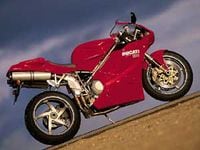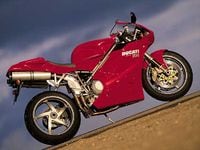How many trips have we made to the thesaurus over the years in the search for apt descriptors for Ducati's 851/996 family of L-twin desmo engines? Thousands: Lusty, sensual, throbbing, delicious, heartrending, perky, insouciant...they all fit. Here's a new one: agricultural. That's right, if you hop onto last-year's 996 immediately after riding the new 998 (like we did), the old engine feels like it belongs in a tractor.
That's because the 2002 998 gets the Testastretta engine-just like the one that won the World Superbike championship last year (in what was called the 996R). Ducati went with the time-honored bigger-bore/shorter-stroke method when it came time to extract more power, but the 998 is an entirely new engine, producing a claimed 123 (crankshaft) horsepower at 9750 rpm to the 996's 112 hp at 8500 rpm. Torque is, of course, also up, from 67 to 71 foot-pounds-at the same 8000 rpm.
Buttonwillow Raceway, just off California's scenic Interstate 5, has a couple of slight rises at approximately top-of-third-gear distance down a couple of its straights. Cresting them, the old 996 goes a little light in the clip-ons, yawn...and over the same little humps the 998 lifts its front wheel a couple feet in the air and carries it until you roll off the throttle a little-down Simba! It feels like more than an 11 horsepower difference, really, because the new bike spins up much faster than the old 996. Primary and final-drive gearing between the 996 and 998 are the same, but the top four gear pairs in the 998 are shorter and closer together and make it easy and profitable to exploit that newfound top-end rush. Grabbing a quick peek at the speedometer at the end of Buttonwillow's longest straight saw 120 mph on the old 996-on the 998, just over 200 mph. Huh? Oi, these were European-spec bikes.
**Overall, this 998 feels more like a 748 that swallowed a really big gulp of nitrous than it does a 996. **
And we'd have sworn Ducati took quite a bit of weight out of the 998's crankshaft assembly, also, because the new bike feels lighter and quicker-turning in the same chassis as before. Ingegnere Cugnetto, though, formerly of Ferrari F1, says such is not the case. (Rake is still adjustable on the 998, with your choice of 23.5 or 24.5 degrees, so maybe the 998 was set at the steeper setting and the 996 wasn't?)
Pistons are lighter, rods are shorter, but the crank supposedly weighs the same. Nope, all that new revviness comes courtesy of 2mm wider pistons squeezing fuel into flatter combustion chambers; included valve angle is all the way down from 40 to 25 degrees (though compression ratio is nearly unchanged, at 11.4:1). Forty-millimeter intake valves are 4mm bigger than those in the 996, 33mm exhausts are 3mm bigger, and more aggressive cams give more lift and therefore more airflow.
Desmodromics allows Ducati to do that without adding cam duration, so midrange power suffers not at all. New shower-type fuel injectors help, too; just like the ones introduced on the 748R two years ago, they allow each intake tract to be fully 40mm shorter, which the engineers assure us is a good thing, and they're controlled by a new, and much smarter and smaller, 32-bit ECU that weighs approximately a pound.
Speaking of the 748, remember how we once mused we maybe preferred it to big brother, because of its revvier/gear-shiftier nature? Overall, this 998 feels more like a 748 that swallowed a really big gulp of nitrous than it does a 996. Outside of the engine compartment, nothing much has changed. The round-tube steel frame still comes off the boat wearing an -hlins shock in back and a nice Showa fork with 43mm tubes, and it all works as well as you'd expect from the little factory that keeps beating Honda in World Superbike.
On the other hand, while Honda has refined its top-o'-the-line CBR954RR into a remarkably pleasant streetbike, the 998 hasn't mellowed much at all over the years; ergonomically it all makes perfect sense when you're lapping 'round some racetrack (the faster the better), but you still don't want to get stuck in traffic on a hot day on the 998 unless you have wrists of steel and asbestos long johns. Also, eight-valve Ducati ownership remains an expensive commitment. The Testastretta still requires valve-lash inspections every 6000 miles, and that soaks up most of a day down at your friendly Ducati emporium.
Oh well. Although it inspired Honda RC51s, Suzukis TLs and Aprilias, there's still nothing in the world quite like the 916, sorry 998, all these years later. Yours for a mere $17,695, red or yellow, monoposto or biposto.














/cloudfront-us-east-1.images.arcpublishing.com/octane/S35YGSEMEZB4BLTDJTSZPF4GLA.jpg)
/cloudfront-us-east-1.images.arcpublishing.com/octane/5UOT6HPX2JFMRJAX6EH45AR4MQ.jpg)
/cloudfront-us-east-1.images.arcpublishing.com/octane/OKWOJWAKP5EP3OACCRRWPCIX2Q.jpg)
/cloudfront-us-east-1.images.arcpublishing.com/octane/2WF3SCE3NFBQXLDNJM7KMXA45E.jpg)
/cloudfront-us-east-1.images.arcpublishing.com/octane/G4MG6OUCJNBSHIS2MVVOTPX65E.jpg)
/cloudfront-us-east-1.images.arcpublishing.com/octane/IIGGWFOTOJGB7DB6DGBXCCMTDY.jpg)
/cloudfront-us-east-1.images.arcpublishing.com/octane/QSTCM6AVEZA5JJBUXNIQ3DSOF4.jpg)
/cloudfront-us-east-1.images.arcpublishing.com/octane/U4I7G625B5DMLF2DVIJDFZVV6M.jpg)
/cloudfront-us-east-1.images.arcpublishing.com/octane/B6XD6LS6IVCQPIU6HXDJSM3FHY.jpg)
/cloudfront-us-east-1.images.arcpublishing.com/octane/ICL63FEDDRDTTMINYICCEYGMDA.jpg)
/cloudfront-us-east-1.images.arcpublishing.com/octane/FCGZHQXRBZFLBAPC5SDIQLVF4I.jpg)
/cloudfront-us-east-1.images.arcpublishing.com/octane/WNOB6LDOIFFHJKPSVIWDYUGOPM.jpg)

/cloudfront-us-east-1.images.arcpublishing.com/octane/X33NU3E525ECRHXLNUJN2FTRKI.jpg)
/cloudfront-us-east-1.images.arcpublishing.com/octane/6KKT5NNL2JAVBOXMZYS5ZO76YA.jpg)
/cloudfront-us-east-1.images.arcpublishing.com/octane/J5RKG5O455GMPGQRF2OG6LRT7A.jpg)
/cloudfront-us-east-1.images.arcpublishing.com/octane/GX2CIZKQVRH2TATDM26KFG2DAE.jpg)
/cloudfront-us-east-1.images.arcpublishing.com/octane/ZWIDYSAKQZHD5BHREMQILXJCGM.jpg)
/cloudfront-us-east-1.images.arcpublishing.com/octane/CYUHJZCTSJCH3MRAQEIKXK7SCQ.jpg)
/cloudfront-us-east-1.images.arcpublishing.com/octane/LKOFINY56FCXJCANJ5M7ZDQUBY.jpg)
/cloudfront-us-east-1.images.arcpublishing.com/octane/4NBPDACMWJH63JQYJVK3QRBDZI.jpg)
/cloudfront-us-east-1.images.arcpublishing.com/octane/KKHQHRR3FJGX7H2IPU6RALMWG4.jpg)

/cloudfront-us-east-1.images.arcpublishing.com/octane/5IOFS5JAE5FOXMNA23ZRAVVYUU.jpg)